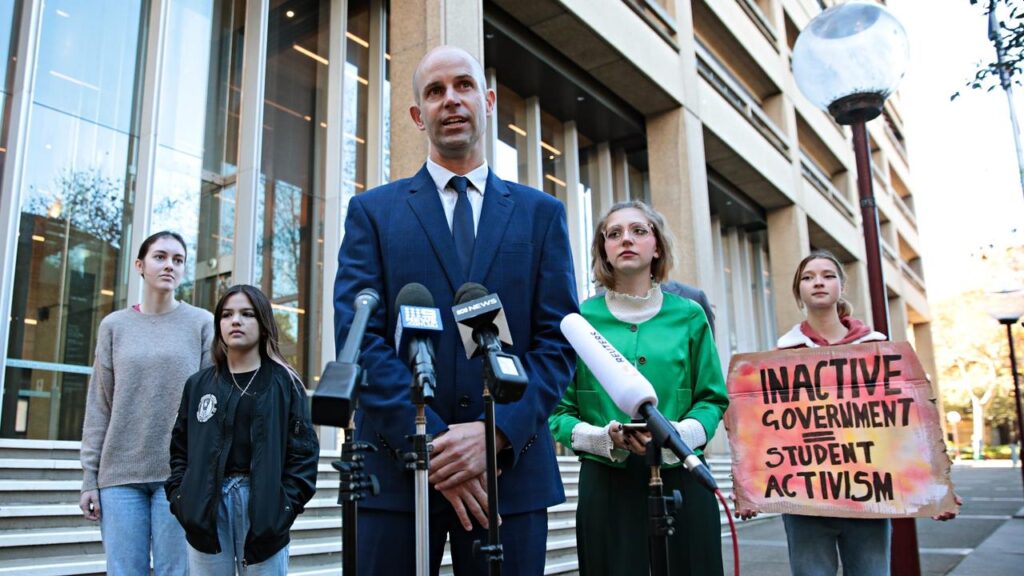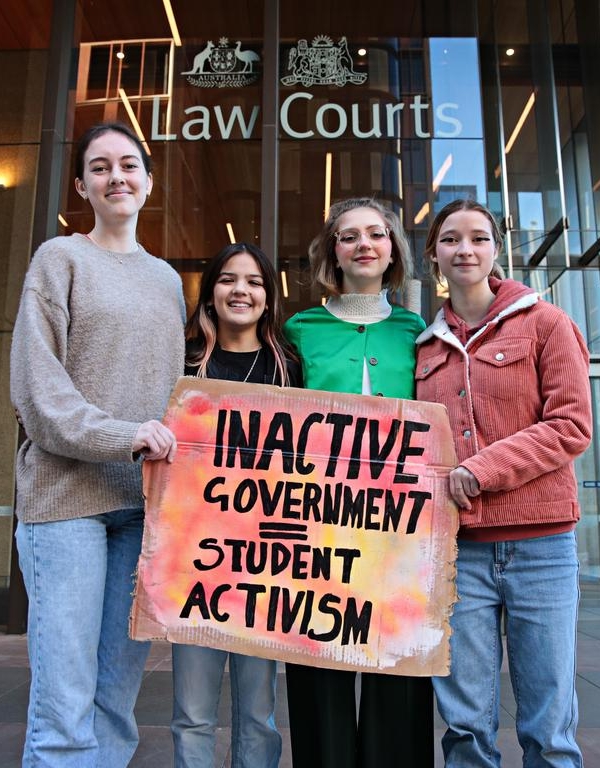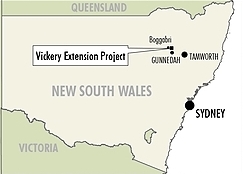This case study examines groundbreaking litigation on the duty of care for climate change in Australia. It initially succeeded at trial but was overturned on appeal.
A courageous and ambitious case
The case was brought by a group of eight brave children led by Anj Sharma (with the assistance of 86 year-old litigation guardian Sister Brigid Arthur), against the Federal Minister for the Environment to protect young people from the future harm caused by the climate change impacts of a proposed coal mine extension project in NSW known as the Vickery Extension Project.

Source: Kids News Picture: NCA NewsWire/Adam Yip
The case was very courageous and ambitious, leaping out of the normal constraints for challenging administrative decisions by taking a pre-emptive attack before a decision was made.
The applicants argued that in deciding whether the approve the coal mine expansion under the Environment Protection and Biodiversity Conservation Act 1999 (Cth) (EPBC Act), the Minister has a duty to protect young people from the devastating impacts of climate change. They asked the Court to grant an injunction to prevent the Minister from doing so before a decision was made.
The Minister denied any duty of care was owed to the children or that the project would cause the harm alleged.
Bromberg J rejected the Minister’s arguments in Sharma v Minister for the Environment [2021] FCA 560 and found (at [491] and [513]):
… the applicants have established that the Minister has a duty to take reasonable care to avoid causing personal injury to the Children when deciding, under … the EPBC Act, to approve or not approve the [coal mine expansion].
Watch Bromberg J deliver the pubic summary of his judgement, which was livestreamed on 27 May 2021 (16 minutes):
A good Podcast explaining the decision is available here (15 minutes).
After allowing time for further submissions, on 8 July 2021 Bromberg J delivered a second decision in which he declared:
The [Minister] has a duty to take reasonable care, in the exercise of her powers under s 130 and s 133 of the [EPBC Act] in respect of [the coal mine expansion], to avoid causing personal injury or death to persons who were under 18 years of age and ordinarily resident in Australia at the time of the commencement of this proceeding arising from emissions of carbon dioxide into the Earth’s atmosphere.
A novel pre-emptive attack
Even though Bromberg J didn’t grant the injunction, the value of seeking it and declarations (rather than wait for judicial review) was that it allowed the applicants to call evidence and run a merits case rather than waiting for the Minister to make biased factual findings.
Given the opportunity to make a decision and findings of fact, the Minister would have undoubtedly used the same formula as previous Federal Environment Ministers have since the Wildlife Whitsunday case in 2006 and the Anvil Hill Case in 2007, that the impacts of approving a mine (or a gas project) on climate change are too “uncertain” and “speculative” and, therefore, can be discounted.
This formula and the limitations of judicial review have allowed the Minister to continue to approve large coal mines (and gas projects) for over a decade while, on paper at least, not disputing climate change is real. The Minister has used this formula many times since these earlier cases, for instance as a basis for approving the massive Adani Mine without finding it would impact on climate change. This formula allows the Minister to avoid outright climate denial while, simultaneously, avoiding recognition of the impacts of approving large coal mines and gas projects. It is a formula straight from the climate delayers handbook (accepting climate change is real but finding any possible excuse to avoid taking immediate action now).
The applicants in Sharma v Minister for the Environment [2021] FCA 560 avoided waiting for the Minister (or a delegate) to make these ritualistic factual findings and, instead, dragged the Minister before a court in which they could tender evidence of climate experts and have the court make findings of fact based on the merits of this evidence and their claim to substantive rights (not merely procedural rights as in judicial review).
They were able to pre-empt the Minister’s decision by seeking a quia timet injunction (quia timet is a Latin term that translates as “because it is feared”). As Bromberg J discussed at [407], a quia timet injunction may be granted where an applicant establishes that what the respondent is threatening and intending to do will cause imminent and substantial damage to the applicant.
In this case the applicants sought a quia timet injunction to restrain the Minister approving the coal mine extension project on the basis that there is a reasonable apprehension that the Minister will approve it, and, thereby, there is a reasonable apprehension of a breach of the duty of care to them.
Bromberg J declined to grant a quia timet injunction because he wasn’t satisfied that the Minister would breach the duty of care once made aware of its existence by a decision of the Court (see [499]-[512]).
The failure to obtain an injunction did not mean that the applicants failed overall before Bromberg J, particularly in the context that it was really more of a vehicle to run the case on the merits and have the court rule on the existence of a duty of care based on evidence from climate scientists.
Faced with the alternative of waiting and seeking judicial review after the Minister (or a delegate) had approved the mine (in which the reasons for the approval would all be stacked against finding liability), the applicants’ choice to pre-empt the decision by attacking it before it was made was truly inspired and novel.
The initial success of their novel, pre-emptive attack on the Minister’s decision before it was even made is jaw-dropping not only for climate law but in terms of Australian administrative law generally.
A truly remarkable decision
In his decision, Bromberg J carefully considered the climate science presented to him. His truly remarkable judgement laid the foundation for an excellent factual basis to defend the Minister’s subsequent appeal (and the Full Court dismissed the Minister’s challenge to his factual findings).
Amongst many other factual findings of the dire impacts of climate change, Bromberg J found at [293]:
“It is difficult to characterise in a single phrase the devastation that the plausible evidence presented in this proceeding forecasts for the Children. As Australian adults know their country, Australia will be lost and the World as we know it gone as well. The physical environment will be harsher, far more extreme and devastatingly brutal when angry. As for the human experience – quality of life, opportunities to partake in nature’s treasures, the capacity to grow and prosper – all will be greatly diminished. Lives will be cut short. Trauma will be far more common and good health harder to hold and maintain. None of this will be the fault of nature itself. It will largely be inflicted by the inaction of this generation of adults, in what might fairly be described as the greatest inter-generational injustice ever inflicted by one generation of humans upon the next.”
Bromberg J’s judgement was clearly written with appeal in mind. It carefully dealt with the facts and made an extensive analysis of the law on establishing a novel duty of care.
Decision overturned on appeal
The Minister announced the day after the declaration was made she would appeal the decision.
The Full Federal Court heard the appeal on 18-20 October 2021 and, on 15 March 2022, allowed the appeal.
While the three judges of the Full Federal Court dismissed the Minister’s challenge to Bromberg J’s factual findings about climate change (and complimented his Honour on the “detailed and careful” judgement), his construction of the EPBC Act and other aspects of his decision are a leap too far for them.
All three judges of the Full Court agreed (for different reasons) that a duty of care should not be imposed on the Minister.
Allsop CJ began his judgment (at [1]-[2]) by noting the facts of climate change were not in dispute and were largely admitted by the Minister:
“The threat of climate change and global warming was and is not in dispute between the parties in this litigation. … Evidence was led [at the trial] … by and large, the nature of the risks and the dangers from global warning, including the possible catastrophe that may engulf the world and humanity was not in dispute.”
Allsop CJ rejected an implied duty of care for human safety existed under the EPBC Act, stating (at [7]):
“the Minister’s appeal against the imposition of a duty of care … that human safety was an implied mandatory statutory consideration should be upheld. The latter implication cannot be derived from the EPBC Act. The primary judge’s conclusions in this respect were not sought to be supported by the respondents. The imposition of the duty should be rejected. First, the posited duty throws up for consideration at the point of breach matters that are core policy questions unsuitable in their nature and character for judicial determination [i.e. this is a matter for the elected government and Parliament to decide, not the courts]. Secondly, the posited duty is inconsistent and incoherent with the EPBC Act. Thirdly, considerations of indeterminacy, lack of special vulnerability and of control, taken together in the context of the EPBC Act and the nature of the governmental policy considerations necessarily arising at the point of assessing breach make the relationship inappropriate for the imposition of the duty.”
Allsop CJ recognised the difficulty of the decision and praised Bromberg J (at [7]):
[My] conclusions reflect differences of view that I have with the evaluative judgments of the primary judge in a field of contention, the imposition of a duty of care in novel circumstances, that is not without difficulty. The primary judge [Bromberg J] considered and dealt with the arguments of the respondents and the Minister in a careful, thorough and clear body of reasons.”
Two key words for liability stand out in Allsop CJ’s decision in this case: “tiny” vs “material”. Allsop CJ repeatedly used the former to find no liability (e.g. [344]-[346]). Future tort cases can still succeed if they establish the contribution to harm is “material”.
There were three very different approaches to disposing of the appeal between Allsop CJ, Beech J and Wheelahan J.
There is an enormous amount of useful analysis by the Full Court for future successful climate litigation in tort. It certainly is not a washout for future climate cases. There is a lot there to build on.
High Court appeal
As they lost before the Full Federal Court, the children had 28 days to apply for special leave to appeal to the High Court; however, on 12 April 2022 they announced they would not be seeking special leave to appeal. In effect, this ended the case.
This remains an amazing decision
Even though Bromberg J’s decision did not survive on appeal, it remains an amazing and groundbreaking decision that will reverberate for many years.
The Full Federal Court rejected the Minister’s challenge to Bromberg J’s factual findings of the dire consequences of climate change on children. The Full Federal Court’s judgment demonstrates the yawning crevasse between the facts in the real world and Australian “environmental” law, as does the Minister’s approval of the mine itself.
The significance of this case needs to be seen in context:
- The successful appeal does not change the factual findings made by the primary judge (Bromberg J) of the horrific future the world faces due to climate change reflects mainstream science and this reality is likely to drive a tidal wave of climate litigation in the future. Coal companies and other fossil fuel producers are like asbestos manufacturers in the 1980s facing a tsunami of litigation.
- The litigation in this case used a statutory scheme (the EPBC Act) that did not directly address climate change or human safety, so it was always a very ambitious and courageous case that pushed the boundaries of the law. The success at trial was remarkable and driven by the judge’s creative response to the uncontested evidence of the harm caused by climate change.
- Only one of the 3 judges on appeal (Allsop CJ) found that response to climate change should be left to Parliament, rather than the courts. Leaving climate change to Parliament by finding these matters are “non-judiciable” would have been a roadblock for future cases. This case is not a roadblock to future climate litigation in other areas such as negligence claims against major GHG emitters like AGL Energy.
- This case is one of hundreds of climate change cases being brought around the world where courts are being called upon to find remedies for the harm suffered by billions of people.
- Two key words for liability stand out in Allsop CJ’s decision in Sharma: “tiny” vs “material”. Allsop CJ repeatedly used the former to find no liability (e.g. [344]-[346]). Future tort cases can still succeed if they establish the contribution to harm is “material”.
- There is an enormous amount of useful analysis by Bromberg J and the Full Court for future successful climate litigation in tort. The result in the appeal certainly is not a washout for future climate cases. There is a lot there to build on.
Groundhog Day as Minister approves mine
Prior to the Full Federal Court overturning Bromberg J’s decision, on 15 September 2021 the Minister granted approval for the proposed mine expansion.
The Minister’s statement of reasons addressed “Duty of care and human safety” at [163]-[282], making a tour de force of the Drug Dealers Defence on climate change (“if we didn’t supply the coal, another mine would, so allowing this mine will have no impact on climate change”).
The Minister found, at [204] (with similar findings elsewhere):
“[204] I accepted the department’s view that the approval of the proposed mine is not likely to cause harm to human safety because, if the proposed action is not approved, it is likely that a comparable amount of coal will be consumed in substitution of the proposed action’s coal. Therefore, I found that the proposed action is unlikely to result in an increase in global GHG emissions.”
The Minister’s approval of the mine using the Drug Dealers Defence while paying lip-service to the duty of care identified by Bromberg J is a Groundhog Day moment, where the past repeats. Whether we are at the start of that movie, or near the end, remains to be seen.
At this point we appear to be somewhere in the middle of the movie where the past repeats rapidly. Two weeks after approving the mine expansion using the Drug Dealers Defence, the Minister relied on the same reasoning to approve another large coal mine, the Mangoola Mine in NSW. That approval authorised extraction of 52 Mt of thermal coal over 8 years, generating around 105 Mt GHG (scope 1, 2 and 3) emissions. The Minister again found in her statement of reasons:
“[200] I accepted the department’s view that the approval of the proposed action is not likely to cause harm to human safety because, if the proposed action is not approved, it is likely that a comparable amount of coal will be consumed in substitution of the proposed action’s coal. Therefore, I found that the proposed action is unlikely to result in an increase in global GHG emissions.”
The virtually verbatim repetition of this formulaic reasoning in approving the two mines is not accidental but, rather, the application of a deliberate strategy (devised by departmental staff and lawyers advising the Minister) to minimise the potential for successful judicial review in relation to the Minister’s reasoning about climate change. The merits of this reasoning cannot be challenged in judicial review. Groundhog Day is likely to keep repeating for the foreseeable future in similar approvals.
Another big crack in the wall defending climate polluters
While the Minister approved the mine and this ambitious litigation was ultimately unsuccessful, this case has created another big crack in the wall defending climate polluters.
These cracks are appearing in the context where liability for climate change is widespread but largely unrealised. This context flows logically from the facts that:
- billions of people and trillions of dollars of property are being and will be impacted by climate change;
- common law causes of action and modern environmental laws are wide on their face and apply to activities that cause climate change in the same way as other forms of pollution;
- a core function of the courts is to provide remedies for people who suffer damage due to the actions of others; and
- despite, on its face, widespread liability, only relatively few cases have been brought globally (somewhere in the order of 1,000), which means that liability is largely unrealised.
In relation to the second of these points, if the common law and modern environmental laws do not address climate change – a well-known, major threat facing human society and the environment, which will cause huge property losses – there is something seriously wrong with them.
It would be wrong to assume this is the case or to assume that judges, faced with clear evidence of harm, will not use (in the words of five judges of the Australian High Court) the “creative element of both inductive and deductive reasoning in the work of the courts” to fashion appropriate remedies.
To the contrary, the opposite is a logical conclusion: widely framed modern environmental laws address climate change impacts, just as they regulate other forms of pollution, and judges will strive to find remedies for clear harm. Yet this liability is largely unrealised as countless human activities across the globe continue to contribute to climate change without attracting legal sanction.
Decisions like those of the trial judge, Bromberg J, in the Sharma case and the Dutch courts in the famous Urgenda case, will continue to strive to find remedies for climate harm in the face of overwhelming evidence. The decision in Sharma is a signpost to this, not a roadblock to it.
The big, unanswered question is when these growing cracks will cause the wall defending climate polluters to burst.
Key documents
Pleadings*
- Amended Originating Application, filed by the Applicants on 15/12/2020.
- Amended Concise Statement, filed by the Applicants on 15/12/2020.
- Concise Statement in Response (effectively a defence), filed by the Minister on 29/10/2020
Expert reports
- Expert report of Dr Karl Mallon, dated 9/12/2020.
Trial decisions
- Decision in Sharma v Minister for the Environment [2021] FCA 560 (Bromberg J), delivered 27 May 2021, finding a duty of care existed but declining to grant the injunction sought.
- Decision in Sharma v Minister for the Environment (No 2) [2021] FCA 744 (Bromberg J), delivered 8 July 2021, declaring the Ministered owed a duty of care and awarding costs to the Applicants.
Appeal
- Notice of Appeal, filed 16 July 2021.
- Appellant’s (Minister’s) Outline of Submissions, filed 13 September 2021.
- Respondent’s Outline of Submissions, filed 24 September 2021.
- Appellant’s Submissions in Reply, filed 4 October 2021.
- Decision allowing appeal, Minister for the Environment v Sharma [2022] FCAFC 35, 15 March 2022.
- Summary of decision released by the Full Court (3 pages), 15 March 2022.
Minister’s approval of mine
- EPBC Act approval of mine and conditions, 15 September 2021.
- Minister’s statement of reasons for approval, 16 September 2021.
* Thanks to the Applicant’s solicitors, Equity Lawyers, for making the pleadings available on their website. Congratulations to David Barden, Emrys Nekvapil and all involved in this case for their vision and courage in bringing it.
Given the significant public interest in the matter, the Federal Court has created a publicly available Online File for the appeal available at this link.
-
Left to right: Laura Kirwan, 17, Izzy Raj-Seppings, 14, Ava Princi, 17, and Liv Heaton.
Source: Kids News Picture: NCA NewsWire/Adam Yip
-
Victorian teen Anjali ‘Anj’ Sharma, 16, helped lead the class action lawsuit by eight Australian teens challenging the Federal Minister for the Environment, Sussan Ley, to protect young people from climate change.
Source: Kids News Picture: Jake Nowakowski
-
Location of Vickery Extension Project
Source: Whitehaven Coal Vickery Extension Project
-
Map of Vickery Extension Project
Source: Whitehaven Coal Vickery Extension Project
-
Lawyer David Barnden speaks to press next to Ava Princi, 17 in front of the Federal Law Courts in Sydney.
Source: Kids News Picture: NCA NewsWire/Adam Yip
Media reports about this case
Class action to stop planned coal mine extension filed by climate action-focused Australian teenagers, ABC News, 9 September 2020.
‘A duty of care’: Australian teenagers take their climate crisis plea to court, The Guardian, 2 March 2021.
Anjali Sharma breaking new ground in climate fight, Sydney Morning Herald, 5 March 2021.
Australian court finds government has duty to protect young people from climate crisis, The Guardian, 26 May 2021.
Australian teenagers’ climate change class action case opens ‘big crack in the wall’, expert says, ABC News, 27 May 2021.
We are passionate climate warriors. Our legal battle is not over but my heart is a bit lighter, The Guardian, 28 May 2021.
Teen environmental activists have a ‘victory’, says lawyer, Kids News, 2 June 2021.
PODCAST: The judgement that changed climate law in Australia, 7am, 5 July 2021.
Judge’s duty-of-care ruling blow for coal, Australian Financial Review, 8 July 2021.
Australian government must protect young people from climate crisis harm, court declares, The Guardian, 8 July 2021.
Australia govt to appeal court ruling on climate change duty of care, Reuters, 9 July 2021.
Children are our future, and they are leading the way on climate change, Environmental Defenders Office, 9 July 2021.
Australian government to appeal ruling that it must protect children from climate harm, The Guardian, 9 July 2021.
“Embarrassing:” Ley to appeal court ruling she has duty of care to young people on emissions, RenewEconomy, 9 July 2021.
‘One more mine does make a difference’: Australian children argue for the climate – and the law agrees, The Guardian, 10 July 2021.
Human rights issue or ‘green lawfare’? Citizens take to the courts to fight climate change, ABC RN, 27 July 2021.
Environment Minister approves Vickery coal mine extension after teenagers’ climate change legal challenge, ABC News, 16 September 2021.
Whitehaven Coal’s Vickery mine given green light by environment minister, The Guardian, 16 September 2021.
Third new coal project approved by Australian environment minister Sussan Ley in just one month, The Guardian, 5 October 2021.
Children’s climate change case overturned on appeal as Federal Court dismisses government’s ‘duty of care’, ABC News, 15 March 2022.
Federal Environment Minister does not have a duty of care to protect children from climate harm: court, SMH, 15 March 2022.
Sussan Ley’s appeal hasn’t overturned the facts in climate case, SMH, 15 March 2022.
Though the children lost their climate case, the war has just begun, SMH, 15 March 2022.
Teen activists vow to keep fighting for ‘climate justice’, despite Federal Court ruling against them, SBS News, 15 March 2022.
In the Sharma decision the federal court says: we see the climate risk but cannot act, The Guardian, 16 March 2022.
No ‘Duty of Care’ but risks of climate litigation continue to grow – insights from the Sharma decision, Gilbert + Tobin, 21 March 2022.
Zoe Bush, Is Climate Change Justiciable? Politics and Policy in Minister for the Environment v Sharma’, Australian Public Law, 29 June 2022.
Climate change litigation risk in Australia, Ashurst, 5 September 2022.
Pocock seeks to impose duty of care on Australian government over climate harm, The Guardian, 31 July 2023.
Teen activist Anjali Sharma wages war on government climate inaction from dorm room, ABC News & Australian Story, 11 March 2024.







